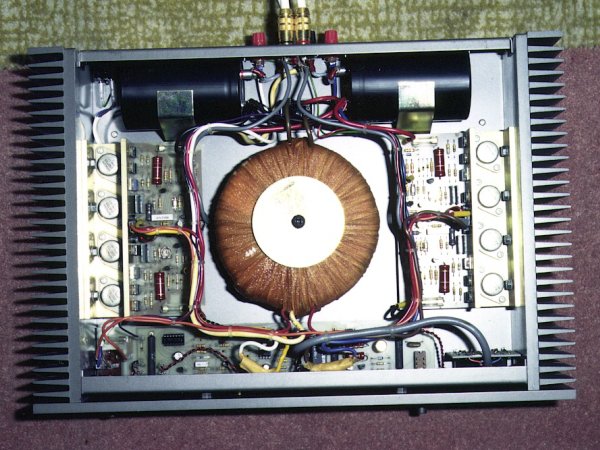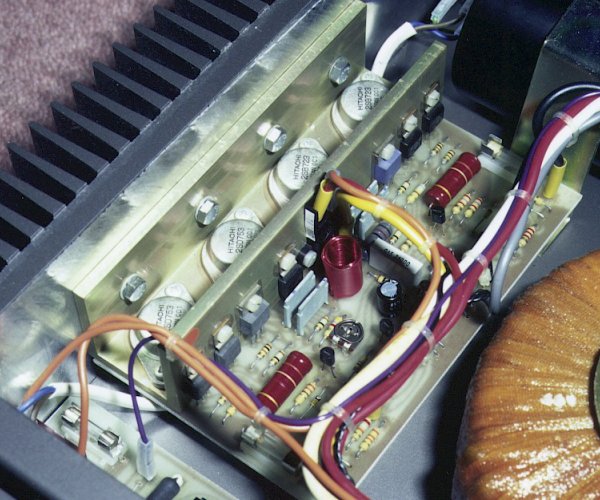The Armstrong 732 Power Amplifier
The picture above shows a view looking down into a 732 Power Amplifier. The mains transformer toroid is in the center of the box. The power amplifier boards (A20s) are at the left and right hand ends of the box, fixed to the heatsinks.
Four power output devices were used for each channel. These can be seen sitting in U-channels bolted to the heatsinks. The drivers, pre-drivers, and the bias splitter are also attached to the inner side of these U-channels. As a result all these devices are in good thermal contact with each other. This ensures that bias conditions do not vary significantly with temperature.
At the back of the box there are two 12,000 microfarad reservoir capacitors and the mains rectifier bridge. The front of the box contains another circuit board which is for the relay, and a circuit which flags any overload or increase in distortion.
The picture above shows a close-up of one of the A20 power amplifier boards.This gives a better view of the devices used. The device at the center of the row of transistors on the inner face of the U-channel is a thermal cut-out which shuts down the power supply if the heatsink temperature reaches 60 Celsius. This isn't needed to protect the amplifier which cheerfully works even when the heatsinks reach 100 degrees! It is to prevent someone burning themselves if the heatsinks become very hot. In practice this cut-out never operated as the heatsinks rarely heated up by more than about 10 degrees even when music was played very loud indeed!
The above image shows the circuit diagram of the power amplifier used in the 732. If you wish to see a larger version, click on the diagram. It just shows the circuit for one A20 circuit board, so there are two identical circuits in each 732 stereo power amp. The device specifications are listed here for those interested.
So far as possible, the circuit topology uses symmetry and balance. The front end consists of two ‘long-tailed pair’ sections biassed with a constant current arrangement. This means their gain behaviour is current controlled Class-A. Hence they tend to reject any power line fluctuations. The first stage is also powered from Zener diodes which set 15 Volt rails. The following stages are current mirrors and current amplifiers which feed the pre-drivers and output current drivers. The whole arrangement has a high degree of rejection of power line fluctuations.
The design achieves two useful effects. Firstly, the balanced symmetric arrangement means a low level of inherent distortion. Secondly, any distortion components on the power lines will be ignored.
In a Class-AB amplifier the current patterns in the power lines tend to be ‘half-wave rectified’ versions of the output current pattern. The positive rail current (and hence voltage fluctuations) follows the positive part of each output cycle, and the negative rail similarly responds to the negative parts of the output waveform. As a result, the current patterns on the rails are highly distorted. Any tendency for the rail current or voltage fluctuations to induce a signal will therefore lead to distortion. In particular, in a stereo amplifier, this may lead to distortion crosstalk. When this arises a high power signal on one channel will induce coherently related distortions into the other channel's output. Even at low levels this may degrade the stereo image.
Class-A designs avoid this problem as the current and voltage fluctuations in their power lines are not distorted in the same way. Hence one advantage of a Class-A system that rarely gets mentioned is that any amplifier sensitivity to rail fluctuations is less likely to lead to distortion, or affect stereo imaging. When designing a high power system, however, Class-A is rarely practical. A Class-AB system must therefore be designed with great care to avoid this effect compromising the dynamic performance.

Content and pages maintained by: Jim Lesurf
using HTMLEdit and TechWriter on a StrongARM powered RISCOS machine.


